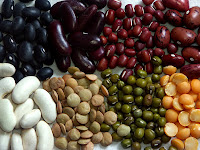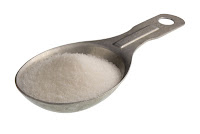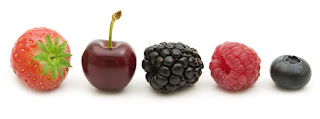There are many sources of protein. Animal products like meat, milk, eggs and yogurt are great sources of protein. However, these animal products also contain unnecessary fat and cholesterol; whereas plant products do not. There are many plants that also contain protein, and the added benefit is that plants do not have cholesterol.
Let’s examine a few plants that contain protein. Soy is probably the most popular. Soybeans are a major crop grown in the Midwest. They can be roasted or boiled and eaten right out of the pod. They are sometimes called Edamame, a Japanese version of salted soybean. Soy is also used to make many other products. Tofu is a product made from fermented soybeans. Tofu comes in a variety of textures and flavors. It can be used as a meat alternative in cooking. Soy is also made into soy milk, soybean oil, tempeh, soy flour, soy yogurt, and soy “nuts.” Soy nuts are just the beans, removed from the pods, and roasted and salted. They make a great crunchy snack!
Nuts are another common source of plant protein. While nuts contain fat, the fat has a high level of beneficial omega-3 fatty acids. Peanuts are a great source of protein, but they are actually a legume, not a nut. Peanut butter is classified as a protein as well! Other legumes would include beans, lentils, peas, chickpeas and more.
One of the best things about getting your protein from plant sources is that you also get fiber. Fiber aids in digestion and can help lower your cholesterol. So, by consuming plant proteins instead of animal proteins, you are getting beneficial fats, no cholesterol and added fiber. It’s a win-win-win!
Protein content of plants (1/2 cup serving):
- Soybeans – 14 grams
- Tofu – 10 grams
- Soy nuts (1/4 cup) – 15 grams
- Soy milk (1 cup) – 6.6 grams
- Walnuts – 24 grams
- Peanuts – 24 grams
- Almonds – 21 grams
- Pistachios – 21 grams
- White Beans – 9 grams
- Black Beans – 8 grams
- Red Kidney Beans – 8 grams
- Lentils – 9 grams
- Chickpeas – 7 grams
For more tips on maintaining a healthy vegetarian diet, download a free pdf of MyPlate: Ten healthy eating tips for vegetarians from MU Extension publications.
Contributors: Erin Plumberg, Dietetic Intern, KU Medical Center; and Ellen Schuster, M.S., R.D., Associate State Specialist, University of Missouri Extension, schusterer@missouri.edu, 573-882-1933






